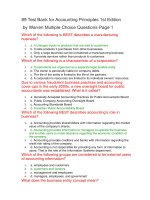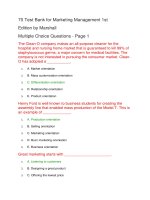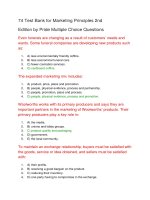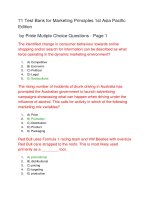71 test bank for marketing principles 1st asia pacific edition
Bạn đang xem bản rút gọn của tài liệu. Xem và tải ngay bản đầy đủ của tài liệu tại đây (99.46 KB, 22 trang )
71 Test Bank for Marketing Principles 1st Asia Pacific
Edition
by Pride Mutiple Choice Questions - Page 1
The identified change in consumer behaviour towards online
shopping and/or search for information can be described as what
force operating in the dynamic marketing environment?
1.
A) Competitive
2.
B) Economic
3.
C) Political
4.
D) Legal
5.
E) Sociocultural
The rising number of incidents of drunk driving in Australia has
prompted the Australian government to launch advertising
campaigns showcasing what can happen when driving under the
influence of alcohol. This calls for activity in which of the following
marketing mix variables?
1.
A) Price
2.
B) Promotion
3.
C) Distribution
4.
D) Product
5.
E) Packaging
Red Bull uses Formula 1 racing team and VW Beetles with oversize
Red Bull cans strapped to the roofs. This is most likely used
primarily as a ________ tool.
1.
A) promotional
2.
B) distributional
3.
C) pricing
4.
D) targeting
5.
E) production
The forces of the marketing environment include:
1.
A) political, legal and regulatory, sociocultural, technological, economic, and
competitive
2.
B) sociocultural, legal, regulatory, economic, and competitive
3.
C) legal, regulatory, political, and sociocultural
4.
D) competitive and non-competitive forces that affect most lifestyles
5.
E) fairly static components.
Consumers buying products online have dramatically affected the
___________ variable of the marketing mix.
1.
A) product
2.
B) price
3.
C) distribution
4.
D) research
5.
E) promotion
When new products—such as Lyrica, a treatment for fibromyalgia
pain—are developed, the companies must develop marketing
activities to reach prescribing medical doctors and communicate the
products’ benefits and side effects. Thus the marketing concept
emphasises that marketing begins and ends with whom?
1.
A) Customers
2.
B) Marketing manager
3.
C) CEO
4.
D) Finance department
Marketers sometimes speak of the “controllable” variables in the
practice of marketing. Which of the following is not considered one
of the controllable variables?
1.
A) Product
2.
B) Price
3.
C) Distribution
4.
D) Competition
5.
E) Promotion
Those constituents who have a "stake" in some aspect of an
organisation's products, operations, markets, industry, and
outcomes are known as:
1.
A) shareholders
2.
B) stakeholders
3.
C) customers
4.
D) target markets
5.
E) marketers.
Marketing is the process of:
1.
A) promoting products through personal selling and advertising to facilitate
satisfying exchange relationships
2.
B) maximising returns to stakeholders by developing relationships with valued
customers and creating a differential advantage
3.
4.
5.
C) delivering a standard of living to a society
D) creating, distributing, promoting, and pricing goods, services, and ideas to
facilitate the achievement of the firm's objectives
E) focusing on customers' needs.
Marketing mix included four marketing activities except which of the
following?
1.
A) Product
2.
B) Price
3.
C) Political forces
4.
D) Promotion
5.
E) Place
The marketing concept is best defined as:
1.
A) a second definition of marketing
2.
B) a philosophy stating that an organisation should try to satisfy customers'
needs through a coordinated set of activities that allows the organisation to
achieve its goals
3.
C) the performance of business activities that direct the flow of goods and
services from producer to customer or user
4.
D) a philosophy stating that an organisation should attempt to accomplish its
goals with no regard for the needs of customers
5.
E) the inclusion of marketing activities in the activities of an organisation.
For an exchange to take place, four conditions must exist. If you go
to a Coldplay concert, for example, you go with the expectation of a
great show. This is an example of the _____ condition where each
party must have confidence in the promise of the ‘something of
value’ held by the other.
1.
A) first
2.
B) second
3.
C) third
4.
D) fourth
To maintain an exchange relationship, buyers must be satisfied with
the goods, service, or idea obtained, and sellers must be satisfied
with what?
1.
A) Profits for the seller
2.
B) A good bargain on the product for the buyer
3.
C) Reducing the seller's inventory
4.
D) One party having to compromise in the exchange
5.
E) The financial reward or something else of value received
The expanded marketing mix includes:
1.
A) product, price, place, promotion
2.
B) people, physical evidence, process and partnership
3.
C) people, promotion, place, process
4.
D) people, physical evidence, process and promotion
For an exchange to occur, four conditions must exist: first, two or
more individuals, groups, or organisations must participate, and
each must possess ‘something of value’ that the other desires;
second, the exchange must provide a benefit or satisfaction to both
parties; third, each must have confidence in the promise of the
‘something of value’ held by the other; and fourth:
1.
A) the parties must agree to participate in the trading of ‘something of value’
2.
B) to build trust, parties to the exchange must meet expectations
3.
C) both parties must participate in the trading of the ‘something of value’
4.
D) one party must be willing to compromise
5.
E) one party must have sufficient bank credit to finance the exchange.
The marketing concept focuses on:
1.
A) achieving the goals of top executives
2.
B) creating maximum visibility for the firm
3.
C) maximising sales
4.
D) maximising market share
5.
E) customer analysis, competitor analysis and integration of the company’s
resources to provide customer value, as well as make the organisation more
valuable for its owners and other stakeholders.
A target market:
1.
2.
A) involves a large number of customers
B) is a specific group of customers on whom a company focuses its marketing
efforts
3.
C) already has several competitors vying for customers' business
4.
D) is the same thing as a salesperson's prospective client list
5.
E) is a customer group classified as people with similar demographic
characteristics.
Campbell’s in Australia responded to consumer concerns about
their health by introducing a line of reduced sodium soups made
with natural sea salt. This illustrates a change in the ___________
for Campbell’s.
1.
A) marketing mix
2.
B) marketing environment
3.
C) marketing concept
4.
D) marketing task
5.
E) product concept
A physical product you can touch is a(n):
1.
A) service
2.
B) good
3.
C) idea
4.
D) concept
5.
E) philosophy.
Marketing managers strive to develop a marketing mix that:
1.
A) minimises marketing costs
2.
B) matches what competitors are offering
3.
C) best matches the abilities of the firm
4.
D) matches the needs of the target market
5.
E) generates the highest level sales.
The concept of ‘exchange’ is fundamental to the definition of
marketing. What is the best description of exchange?
1.
A) Activities that are performed primarily by producers and manufacturers
2.
B) Development of products, distribution channels, promotional strategies,
and pricing objectives to satisfy customer requirements
3.
C) Transfer of products in return for monetary considerations
4.
D) Provision or transfer of goods, services, or ideas in return for something of
value
5.
E) Transfer of products that take place only between for-profit organisations
The Australian airline Jetstar Airways, for example, _______ its
domestic flights in Australia to people who want to fly to a
destination without having to pay for meals and other things that are
not essential to arriving at the destination safely and in good spirit.
1.
A)arranges
2.
B) prepares
3.
C) provides
4.
D) targets
The focal point of all marketing activities is:
1.
A) products
2.
B) the marketing mix
3.
C) profits
4.
D) sales
5.
E) customers.
Land Rover’s Freelander, for example, combines a SUV with
coordinated distribution, promotion and price appropriate for the
_______ ______of primarily well-off men and women in their thirties
andforties.
1.
A) target market
2.
B) consumer advocates
3.
C) marketing strategy
4.
D) marketing mix
5.
E) marketing tactic
Which of the following statements about marketing environment
forces is not correct?
1.
A) They influence customers by affecting their lifestyles, standards of living,
and preferences and needs for products
2.
B) They may influence customers' reactions to a firm's marketing mix
3.
C) They fluctuate slowly and thereby create threats to a firm's marketing mix
4.
D) They can fluctuate quickly and dramatically
5.
E) They help determine whether and how a marketing manager can perform
certain marketing activities
The Australia Zoo in Queensland is in the business of what?
1.
A) Establishing zoos
2.
B) Making people happy and giving them memorable experiences
3.
C) Making animals perform
4.
D) Teaching about endangered animals
Which of the following scenarios involves the distribution element of
the marketing mix?
1.
2.
A) Deciding whether a certain product should continue to be sold.
B) Determining whether an advertising message would be more effective on
television or in magazines.
3.
C) Choosing between a company jet or an airline for executive travel.
4.
D) Deciding whether to have retail outlets in addition to a website.
5.
E) Developing a new warranty policy for an existing product.
When Campbell's introduced a line of low-sodium soups in
response to customer demand, it was following which one of the
following philosophies?
1.
A) Selling concept
2.
B) Production concept
3.
C) Customer concept
4.
D) Marketing concept
5.
E) Retailing concept
Apple has benefitted from technological advances in distributing
songs over the Internet via its iTunes store, rather than establishing
brick and mortar venues to sell music. This is an example of which
element of the marketing mix?
1.
A) Price
2.
B) Distribution
3.
C) Product
4.
D) Promotion
The product variable of the marketing mix can include all of the
following except:
1.
A) creation of brand names
2.
B) consumer perception of the product price
3.
C) development of product packaging
4.
D) warranty issues
5.
E) repair services.
Marketing efforts are designed to:
1.
A) distribute “something of value” to buyers and sellers
2.
B) facilitate satisfying exchange relationships
3.
C) produce a product
4.
D) explore customer behaviour
5.
E) promote a product.
According to the marketing concept, an organisation should try to:
1.
2.
A) consider short-run objectives and cash flow needs before developing new
products
B) define its business as ‘making a product’
3.
C) provide products that satisfy customers' needs and allow the organisation
to achieve its goals
4.
D) put most of its emphasis on marketing activities and be less concerned
with finance, accounting, and personnel
5.
E) view selling activities as the major means of increasing profits.
The marketing environment is best described as being:
1.
A) composed of controllable variables
2.
B) composed of variables independent of one another
3.
C) an indirect influence on the performance of marketing activities
4.
D) one that can fluctuate quickly and dramatically
5.
E) slow, with infrequent fluctuations.
The marketing concept is a philosophy that states that an
organisation should try to satisfy customers' needs and also:
1.
A) increase market share
2.
B) increase sales
3.
C) achieve the organisation's goals
4.
D) produce high-quality products
5.
E) coordinate its activities to increase production.
Responding to health concerns from consumers, McDonald’s, for
example, revamped their menu to include healthier children’s menu
options, such as fruit bags and chicken wraps instead of fries and
hamburgers. This is an example of marketing mangers responding
to what?
1.
A) Operating situation
2.
B) Environmental forces
3.
C) Surroundings
4.
D) Economic conditions
71 Free Test Bank for Marketing Principles 1st Asia
Pacific Edition by Pride Mutiple Choice Questions Page 2
Marketing management is defined as a process of:
1.
A) maintaining an appropriate and efficient marketing mix for a target market
2.
B) establishing performance standards and evaluating actual performances
against these standards
3.
C) providing products that satisfy customers' needs through a coordinated set
of activities
4.
D) facilitating satisfying exchanges between an organisation and its
customers
5.
E) planning, organising, implementing, and controlling marketing activities to
facilitate exchanges effectively and efficiently.
A systematic process of assessing opportunities and resources,
determining marketing objectives, and developing a marketing
strategy and plans for implementation and control describes which
of the following marketing management activities?
1.
A) Strategic planning
2.
B) Marketing control
3.
C) Implementation
4.
D) Organising
5.
E) Planning
Customer benefits include ________ a buyer receives in an
exchange.
1.
A) the product
2.
B) the service
3.
C) the value
4.
D) anything
In today's market environment, you might pay $16 for a new CD.
According to the text approximately how much of that price would
go to activities related to marketing (distribution, retailer expenses,
profit margins)?
1.
A) $1.70
2.
B) $3.75
3.
C) $5.50
4.
D) $9.00
5.
E) $12.75
Which element of the marketing mix can be used to enhance
perceptions of value through images?
1.
A) Product
2.
B) Price
3.
C) Place
4.
D) Promotion
5.
E) People
Amazon, the provider of books, CDs, DVDs, toys and many other
products online, follows buyers’ purchases and recommends
related topics. The firm is exhibiting characteristics associated with
which of the following orientations?
1.
A) Production
2.
B) Sales
3.
C) Marketing
4.
D) Social
5.
E) Development
The marketing concept is not a second definition of marketing, it is
a marketing philosophy guiding:
1.
A) marketing activities
2.
B) an organisation’s overall activities
3.
C) the efforts of sales personnel
4.
D) customer relations
5.
E) only business organisations.
A marketing orientation is an organisation-wide effort that includes
all of the following activities except:
1.
A) researching customers' needs
2.
B) focusing on the marketing department only
3.
C) generating marketing intelligence for use in the organisation
4.
D) being responsive to customers' ever-changing wants and needs
5.
E) disseminating marketing intelligence across departments within the
organisation.
Green marketing is:
1.
2.
A) a strategic process involving stakeholder assessment to create meaningful
long term relationships with customers while maintaining, supporting and
enhancing the natural environment
B) when a company applies recycling principles in their production
3.
C) when a company only uses the internet to advertise and no paper-based
activities
4.
D) when a company meets legislative requirements for waste management.
For most firms, the costs of marketing activities consume
approximately what portion of the consumer's dollar?
1.
A) One-half
2.
B) One-fifth
3.
C) One-fourth
4.
D) One-third
5.
E) One-sixth
The marketing concept is:
1.
A) a managerial philosophy
2.
B) synonymous with exchange
3.
C) a component of the marketing mix
4.
D) a function of the marketing environment
5.
E) focused solely on satisfying customer objectives.
_________ of marketing plans hinges on coordination of marketing
activities, motivation of marketing personnel, and effective
communication within the marketing unit.
1.
A) Implementation
2.
B) Planning
3.
C) Organising
4.
D) Marketing control
5.
E) Strategic planning
At the most basic level, profits can be obtained through
relationships in which of the following ways, except which of the
following?
1.
A) By acquiring new customers
2.
B) By enhancing the profitability of existing customers
3.
C) Continually selling to only old customers and markets
4.
D) By extending the duration of customer relationships
Marketing activities:
1.
A) are aimed at persuading customers through advertising
2.
B) involve mainly distribution and promotion decisions
3.
C) and selling activities are basically the same
4.
D) are important only when a firm is developing new products or entering new
markets
5.
E) help sell an organisation's products and generate financial resources for
the firm.
The evolution of the marketing concept has moved from production
orientation from the 1850’s to what orientation currently?
1.
A) Sales
2.
B) Market
3.
C) Customer
4.
D) Relationship
5.
E) Economic
A mid-level manager has tried for years to get his company to adopt
a marketing orientation. Although many in the company are
receptive to his ideas, it is unlikely that the company will ever truly
become marketing-oriented without:
1.
A) the support of competitors
2.
B) changes in government regulations
3.
C) increases in tariffs on foreign products
4.
5.
D) the support of executives, marketing managers, non-marketing managers
and customers
E) the consent of assembly-line workers.
Many eBay-based businesses use what type of guarantee to
reduce the risk involved in ordering merchandise sight unseen?
1.
A) Photographs
2.
B) Customer satisfaction ratings
3.
C) Email contacts
4.
D) 100 per cent satisfaction guarantee
5.
E) Monetary price
If McDonald's runs a promotion advertising Big Macs for 99 cents, it
must ensure that each of the company's restaurants has sufficient
staff and product on hand to handle expected demand. This relates
to which of the following marketing management activities?
1.
A) Strategic planning
2.
B) Planning
3.
C) Organising
4.
D) Implementation
5.
E) Marketing control
Establishing long-term, mutually satisfying buyer-seller relationships
is known as:
1.
A) marketing synthesis
2.
B) relationship marketing
3.
C) a marketing orientation
4.
D) the marketing concept
5.
E) strategic marketing.
An Apple iPod has average marketing costs and sells for $299.
Approximately how many buyers’ dollars go toward marketing
costs?
1.
A) $50
2.
B) $90
3.
C) $150
4.
D) $175
5.
E) $199
Marketing activities are:
1.
2.
A) used by all sizes of organisations including non-profit, and government
agencies
B) limited to use by larger for-profit and non-profit organisations
3.
C) implemented only to increase profits for the organisation and to expand the
scope of its customer base
4.
D) used by all types and sizes of businesses but are not used by non-profit
organisations
5.
E) used by small businesses and small non-profits the most.
Businesspeople who believe that personal selling, advertising, and
distribution are the most important marketing activities are operating
in a(n) ___________ orientation.
1.
A) marketing
2.
B) societal
3.
C) sales
4.
D) evolutionary
5.
E) production
Developing the internal structure of a firm's marketing unit relates to
which of the following marketing management activities?
1.
A) Marketing control
2.
B) Implementation
3.
C) Organising
4.
D) Planning
5.
E) Managing
Customer relationship management focuses on using ___________
about customers to create marketing strategies.
1.
A) internal communication
2.
B) information
3.
C) purchasing power insights
4.
D) marketing mix knowledge
5.
E) implementation knowledge
Which of the following would not be a customer cost considered in
determination of product value?
1.
A) Product's purchase price
2.
B) Time spent purchasing the product
3.
C) Effort spent purchasing the product
4.
D) Benefits received in the exchange for the products
5.
E) Risk of purchasing the product
_________ is the process of establishing performance standards,
comparing actual performance with established standards, and
reducing the difference between desired and actual performance.
1.
A) Internal control analysis
2.
B) Marketing control
3.
C) Market flow regulation
4.
D) Environmental market analysis
5.
E) External analysis
Customer costs include anything the buyer must give up to obtain
the benefits the product provides. The most obvious customer cost
is:
1.
A) risk
2.
B) time
3.
C) monetary price
4.
D) effort
5.
E) availability.
All of the following are marketing management tasks except:
1.
A) planning
2.
B) implementing
3.
C) organising
4.
D) analysing target markets
5.
E) controlling.
The 1950s saw the ‘vacuum cleaner salesman’ arrive at the
housewife’s front door with a charming smile and a product
demonstration that ‘makes life easier’—those were the hard sell
days. They were following which orientation?
1.
A) Production
2.
B) Sales
3.
C) Marketing
4.
D) Customer
5.
E) Societal
Key trends from today to the future to be acknowledged include the
following except:
1.
A) convergence of telecommunications, media and technology
2.
B) greater focus on protecting the environment
3.
C) focus on quality and long-term customer relationships to increase
profitability in the long term
4.
D) technology is enabling consumers to connect to other consumer and to
form alliances with other consumers world wide
5.
E) greater false advertising.
As the Industrial Revolution came during the second half of the
nineteenth century, firms operated in a(n) ___________
orientation.
1.
A) marketing
2.
B) societal
3.
C) sales
4.
D) evolutionary
5.
E) production
Marketing knowledge and skills:
1.
2.
A) are not necessary for a non-profit organisation
B) enhance consumer awareness and help provide people with satisfying
goods and services
3.
C) constitute the marketing mix
4.
D) were most important during the production era
5.
E) are most valuable for advertising executives but less important for
wholesalers and distributors.
Today’s society could be described as post-industrial and going
through what type of revolution?
1.
A) Customer driven
2.
B) Research and development.
3.
C) Technological.
4.
D) Slow growth
5.
E) Marketing
________ is a customer's subjective assessment of benefits
relative to costs in determining the worth of a product.
1.
A) Marketing orientation
2.
B) Monetary price
3.
C) Product assessment
4.
D) Price assessment
5.
E) Value
The strategic bridge between information technology and marketing
strategies aimed at long-term relationships is known as what?
1.
A) Personal selling
2.
B) Customer relationship management
3.
C) Production oriented firms
4.
D) e-Marketing
5.
E) Distribution channels
As a concept, customer relationship management (CRM) begins its
focus on customers with:
1.
A) information
2.
B) product
3.
C) distribution
4.
D) communication
5.
E) price.









